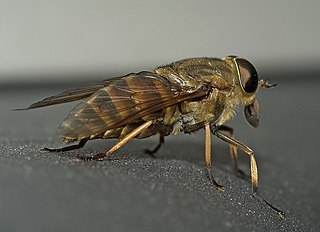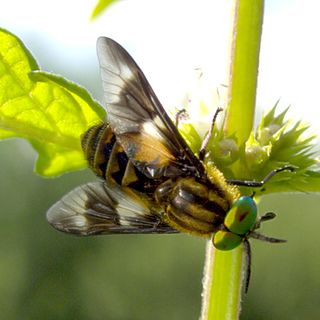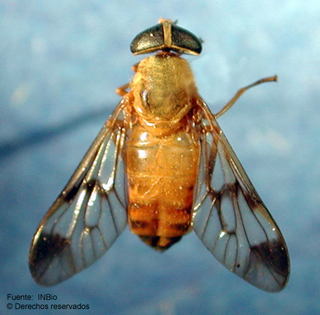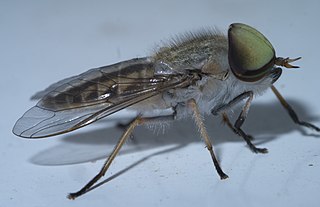
Apatolestes is a genus of horse flies.

Tabanus nigrovittatus, also known as the greenhead horse fly, salt marsh greenhead, or simply the greenhead fly, greenhead or greenfly, is a species of biting horse-fly commonly found around the coastal marshes and wetlands of the Eastern United States. They are smaller than most horsefly species, instead being close in size to a common housefly. The biting females are a considerable pest to both humans and animals while they seek a source of blood protein to produce additional eggs: greenhead larvae develop in the mud of salt marshes, and adult flies mate and lay their first group of eggs in the marsh, but to lay more eggs a female fly needs to drink an animal's blood, and so female greenheads which have laid eggs fly inland to look for prey in the area bordering the marsh; they can stay on land looking for animals to bite for up to four weeks. Their bites are more painful than those of mosquitoes, since greenheads feed by cutting a wound in the skin with scissor-like mouth parts and sucking the blood released through it. Females live for three to four weeks and may lay about 100 to 200 eggs per blood meal. The eggs are laid on the grass in a salt marsh; the larvae live in the intertidal mud of the salt marsh for one or two years, preying on other invertebrates, before pupating in early spring. The adult flies emerge in late spring and are most common from late June to August.

Tabanus sudeticus, also known as the dark giant horsefly, is a species of biting horse-fly. It is the heaviest fly in Europe.

Tabanus lineola, also known as the striped horse fly, is a species of biting horse-fly. It is known from the eastern coast of North america and the Gulf coast of Mexico.

Superfamily Tabanoidea are insects in the order Diptera.

Diachlorus ferrugatus, commonly known as the yellow fly in the United States or doctor fly in Belize, is a species of highly aggressive biting horse-fly of the family Tabanidae native to North and Central America to Costa Rica.
Hybomitra lurida is a species of horse-fly in the family Tabanidae. It is found across central and Northern Europe and Asia. It is a large fly, between 12–15 millimetres long.

Tabaninae is a subfamily in the family Tabanidae commonly known as horse flies. There are more than 3000 described species in Tabaninae.

Chrysopsinae is an insect subfamily in the family Tabanidae commonly known as deer flies or sheep flies and are bloodsucking insects considered pests to humans and cattle. They are large flies with large brightly-coloured compound eyes, and large clear wings with dark bands. They are larger than the common housefly and smaller than the horse-fly.
Tabanus conterminus is a species of horse fly in the family Tabanidae.

Chlorotabanus is a genus of horse flies in the family Tabanidae. Though there were earlier descriptions of the genus, they did not fit the qualification of the Code of the International Zoological Nomenclature, thus the genus was officially accepted in 1913 by the scientific community.

Tabanus trimaculatus is a species of horse fly in the family Tabanidae.

Tabanus punctifer, commonly known as the western horse fly, is a species of horse fly in the family Tabanidae. This species of horse fly is approximately 20.5 mm long. They are typically found throughout the southern and western parts of the United States. They can be found between Utah and Mexico, and between California and Texas. The thorax is covered with long hairs that give it a creamy white color, while the abdomen is completely black. Much like other horse fly species, the Tabanus punctifer female requires a blood meal for the development of their eggs. Females will bite horses, livestock, and humans, making them vectors of disease for pathogens and parasites.
Chrysops excitans is a species of deer fly in the family Tabanidae.
Acanthocera is a genus of flies belonging to the family Tabanidae.

Pangoniinae is a subfamily of horse-flies in the order Diptera, containing at seven tribes and over 40 genera.
Chrysops provocans is a species of deer fly in the family Tabanidae.

Silvius abdominalis is a species of horse fly in the family Tabanidae.
Phaeotabanus is a genus of horse flies in the family Tabanidae.
Acanthocera longicornis is a species of horse flies in the family Tabanidae.















